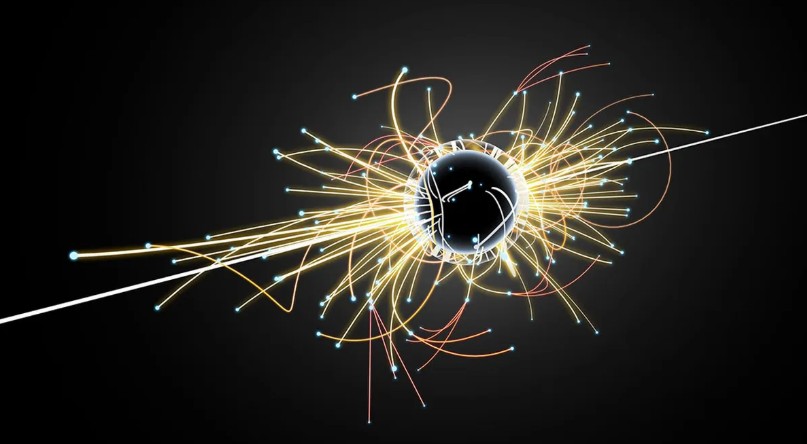


The detailed analysis of the Hubble Space Telescopeimage of the new interstellar object 3I/ATLAS (discussed here and here), implies a total column density of dust particles that is smaller than 10-4 grams per square centimeter. Irrespective of the size distribution of dust particles, this low column density implies that the dust responsible for the glow around 3I/ATLAS is not opaque to sunlight.
Given this, most of the reflected sunlight must originate from the solid surface of the nucleus of 3I/ATLAS. Based on the brightness of the nucleus, its implied radius is about 10 kilometers divided by the square root of the albedo (reflectance) in units of 5%. For the same reason, most of the reddening observed in the spectrum of 3I/ATLAS must originate from the surface of the nucleus. This appearance is reminiscent of the red surface of Kuiper belt objects, such as Arrokoth, which were exposed to a similar dose of interstellar cosmic-rays.
The observed luminosity of 3I/ATLAS is about 10 gigawatts. The simplest interpretation is that it originates from the reflection of sunlight implying an object radius of 3–10 kilometers. However, the previous interstellar objects, 1I/`Oumuamua and 2I/Borisov, were both hundreds of meters in radius and one would expect to find many more of similar-scale interstellar objects before discovering an interstellar rock that is a hundred times larger and a million times more massive. As argued in my first paper on 3I/ATLAS (accessible here), the reservoir of rocky materials in interstellar space can only supply a rare 10-kilometer rock every 10,000 years or longer.
Buried in the barrage of hundreds of emails that I had received today, there was a very interesting question: “Is 3I/ATLAS made of antimatter?”
Before my morning jog at sunrise, I calculated the annihilation rate of the ambient zodiacal dust in the ecliptic plane of the Solar system as the surface of the nucleus of 3I/ATLAS scoops it in case that surface is made of anti-atoms. For a nucleus radius of 10 kilometer, the result was a gamma-ray luminosity of a few gigawatts, coincidentally comparable to the power emitted by 3I/ATLAS in visible light. To account for the observed light, this power in high-energy radiation must be processed through an opaque blanket of matter close to the surface of 3I/ATLAS with an effective photosphere temperature similar to that of the Sun.
Most of the annihilation power is expected to originate from the forward-facing side of 3I/ATLAS as it moves through the ambient zodiacal medium, for the same reason that the front of our body gets more wet when we run through rain. It would be possible to distinguish heating on the forward moving front from heating by sunlight when 3I/ATLAS reaches perihelion, since its motion at that time will be perpendicular to the direction of the Sun. Travel through the interstellar medium would result in a negligible erosion of the surface for a 10-kilometer object.
The annihilation process should generate residual gamma-rays and X-rays that could be detected by the Fermi Gamma-Ray Space Telescope or the Chandra X-ray observatory as the object gets closer to Earth. Here’s hoping that both telescopes will observe 3I/ATLAS in the coming months.
The possibility that 3I/ATLAS is made of antimatter is rather exotic. Antimatter cannot survive annihilation with matter at the high densities that characterized the early Universe. It is created by high-energy processes in negligible quantities relative to the reservoir of matter within most astrophysical environments. Therefore, a spacecraft might contain large quantities of antimatter as fuel or enclosure, only if its maker were able to manufacture this rare substance at scale technologically.
The mix of matter and antimatter offers the most efficient fuel which converts mass to energy with a 100% efficiency.
On Earth, it is very expensive to create antimatter. The particle accelerators at CERN produce a hundredth of a nanogram 10 -11 grams of antimatter at the cost of a kilogram (10³ grams) of gold. The cost of producing 1 gram of antimatter is therefore about 5 quadrillion dollars. At CERN antihydrogen atoms are being produced to test whether they behave like hydrogen atoms, as expected from the fundamental principles of quantum mechanics. One of the main challenges is a method to store antimatter while protecting it from annihilation with the abundant matter surrounding it.
Naturally, antimatter can be produced either by creating an extremely hot medium where pairs of energetic particles are produced or through nuclear processes — such as the decay of unstable atomic nuclei.
For example, the radioisotopes in a banana produce roughly one positron (anti-electron) per hour.
Within our current technological and scientific state, it is an insurmountable challenge to produce antimatter in large enough quantities to fuel or construct a spacecraft. Nevertheless, this should not deter us from searching for any anomalous gamma-ray or X-ray emission by 3I/ATLAS at flux levels that are detectable by the Fermi Gamma-Ray Space Telescope or the Chandra X-ray observatory.
∞
is the head of the Galileo Project, founding director of Harvard University’s — Black Hole Initiative, director of the Institute for Theory and Computation at the Harvard-Smithsonian Center for Astrophysics, and the former chair of the astronomy department at Harvard University (2011–2020). He is a former member of the President’s Council of Advisors on Science and Technology and a former chair of the Board on Physics and Astronomy of the National Academies. He is the bestselling author of “Extraterrestrial: The First Sign of Intelligent Life Beyond Earth” and a co-author of the textbook “Life in the Cosmos”, both published in 2021. The paperback edition of his new book, titled “Interstellar”, was published in August 2024.

